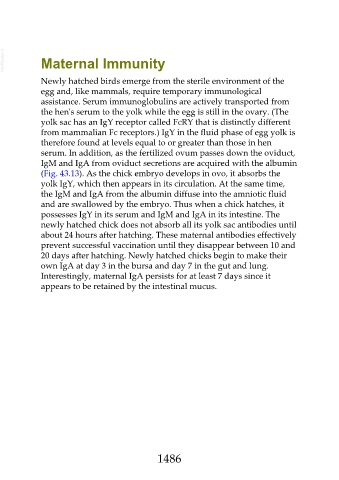Page 1486 - Veterinary Immunology, 10th Edition
P. 1486
VetBooks.ir Maternal Immunity
Newly hatched birds emerge from the sterile environment of the
egg and, like mammals, require temporary immunological
assistance. Serum immunoglobulins are actively transported from
the hen's serum to the yolk while the egg is still in the ovary. (The
yolk sac has an IgY receptor called FcRY that is distinctly different
from mammalian Fc receptors.) IgY in the fluid phase of egg yolk is
therefore found at levels equal to or greater than those in hen
serum. In addition, as the fertilized ovum passes down the oviduct,
IgM and IgA from oviduct secretions are acquired with the albumin
(Fig. 43.13). As the chick embryo develops in ovo, it absorbs the
yolk IgY, which then appears in its circulation. At the same time,
the IgM and IgA from the albumin diffuse into the amniotic fluid
and are swallowed by the embryo. Thus when a chick hatches, it
possesses IgY in its serum and IgM and IgA in its intestine. The
newly hatched chick does not absorb all its yolk sac antibodies until
about 24 hours after hatching. These maternal antibodies effectively
prevent successful vaccination until they disappear between 10 and
20 days after hatching. Newly hatched chicks begin to make their
own IgA at day 3 in the bursa and day 7 in the gut and lung.
Interestingly, maternal IgA persists for at least 7 days since it
appears to be retained by the intestinal mucus.
1486

